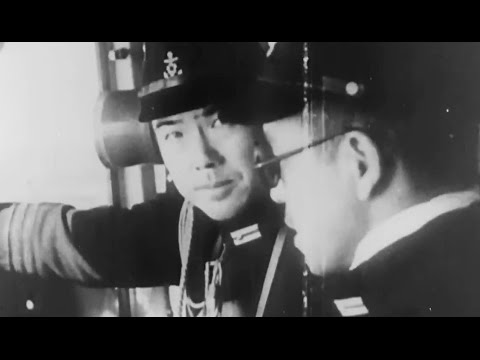World War II playlist:
more at
Japanese-produced propaganda newsreel shows the attack on Pearl Harbor on December 7, 1941 (December 8 in Japan). Titles proclaim “U.S. Pacific Fleet Annilhilated!” French titles at the end of the clip indicate it is part of a series of propaganda films produced in Japan for foreign distribution.
Public domain film from the National Archives, slightly cropped to remove uneven edges, with the aspect ratio corrected, and one-pass brightness-contrast-color correction & mild video noise reduction applied.
The soundtrack was also processed with volume normalization, noise reduction, clipping reduction, and/or equalization (the resulting sound, though not perfect, is far less noisy than the original).
The attack on Pearl Harbor (called Hawaii Operation or Operation AI by the Japanese Imperial General Headquarters (Operation Z in planning) and the Battle of Pearl Harbor) was a surprise military strike conducted by the Imperial Japanese Navy against the United States naval base at Pearl Harbor, Hawaii, on the morning of December 7, 1941 (December 8 in Japan). The attack was intended as a preventive action in order to keep the U.S. Pacific Fleet from interfering with military actions the Empire of Japan was planning in Southeast Asia against overseas territories of the United Kingdom, the Netherlands, and the United States.
The base was attacked by 353 Japanese fighters, bombers and torpedo planes in two waves, launched from six aircraft carriers. All eight U.S. Navy battleships were damaged, with four being sunk. Of these eight damaged, two were raised, and with four repaired, six battleships returned to service later in the war. The Japanese also sank or damaged three cruisers, three destroyers, an anti-aircraft training ship, and one minelayer. 188 U.S. aircraft were destroyed; 2,402 Americans were killed and 1,282 wounded. The power station, shipyard, maintenance, and fuel and torpedo storage facilities, as well as the submarine piers and headquarters building (also home of the intelligence section) were not attacked. Japanese losses were light: 29 aircraft and five midget submarines lost, and 65 servicemen killed or wounded. One Japanese sailor was captured.
The attack came as a profound shock to the American people and led directly to the American entry into World War II in both the Pacific and European theaters. The following day (December 8), the United States declared war on Japan. Domestic support for isolationism, which had been strong, disappeared. Clandestine support of Britain (for example the Neutrality Patrol) was replaced by active alliance. Subsequent operations by the U.S. prompted Germany and Italy to declare war on the U.S. on December 11, which was reciprocated by the U.S. the same day.
There were numerous historical precedents for unannounced military action by Japan. However, the lack of any formal warning, particularly while negotiations were still apparently ongoing, led President Franklin D. Roosevelt to proclaim December 7, 1941, “a date which will live in infamy”…
Admiral Hara Tadaichi summed up the Japanese result by saying, “We won a great tactical victory at Pearl Harbor and thereby lost the war.”… the U.S. Navy had decided as far back as 1935 to abandon ‘charging’ across the Pacific towards the Philippines in response to an outbreak of war (in keeping with the evolution of Plan Orange). The U.S. instead adopted “Plan Dog” in 1940, which emphasized keeping the IJN out of the eastern Pacific and away from the shipping lanes to Australia while the U.S. concentrated on defeating Nazi Germany.
Fortunately for the United States, the American aircraft carriers were untouched by the Japanese attack… As it was, the elimination of the battleships left the U.S. Navy with no choice but to rely on its aircraft carriers and submarines—the very weapons with which the U.S. Navy halted and eventually reversed the Japanese advance. While six of the eight battleships were repaired and returned to service, their relatively slow speed limited their deployment, and they served mainly in shore bombardment roles…
Ultimately, targets not on Genda’s list, such as the submarine base and the old headquarters building, proved more important than any battleship. It was submarines that immobilized the Imperial Japanese Navy’s heavy ships and brought Japan’s economy to a virtual standstill…

